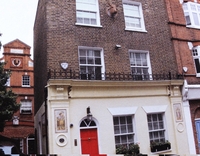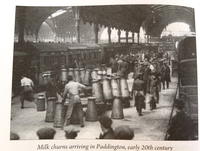Taffy the Milk
TAFFY the MILK
Run out of milk in London in the 19th century? Pop down to the local park with your jug & get a pinta fresh from the cow. There were twelve (cows) tethered in St James's Park in the summer months.
Or else your milk came to you – courtesy of a milkmaid. (#1) She carried 15 gallons in two buckets on a yoke round her shoulders & shouted “Milko!”, returning to base to replenish her 100lb load till 6pm or until her 3-mile ‘milk-walk' was complete. She was paid nine bob a week + breakfast.
The milkmaids were mostly ‘strong & sturdy' Welsh girls from Cardiganshire who had joined a drove to London. They worked for ‘cowkeepers', many of them ex-drovers who had decided to give up the itinerant life for a steadier one. Railways, the promise of more money, women – all played their part: the marriage registers of fringe London boroughs are full of Welsh surnames...
...which can also be found in the lists of C19 cowkeepers: in 1890 we find 285 registered cowkeepers, 116 with Welsh surnames; in 1900 the figures are 168 & 82; in 1910, 102 & 471
* * *
Not all cows sold at Smithfield went for fattening: some were used for the developing milk market. The short shelf-life of milk led to hundreds of small dairies springing up all over London, many run by Welshmen, who, after all, knew the beasts.
Charles Booth's famous report on Life & Labour in London (1886) said that only the Welsh could accept the conditions under which cattle-keepers were compelled to live and work in order to make a living. “They are mostly of low education and have an imperfect grasp of English, but they are frugal and self-denying.”
Cows were kept in cellars, even hoisted up to garrets. All were replaced when their yield dropped. One pair of Welsh brothers kept two milking herds, one in Wales & one in London. Every six months they met at Tewkesbury – and swapped herds.
By 1871 there were 24,000 milch cows in the capital, supplying ¾ of London's milk. Mr Rhodes of Islington kept 100; most cowkeepers about a dozen. They were fed on grain from nearby breweries and unwanted vegetables from local markets. Their manure was taken by barge down the Thames to fertilise the gardens of Surrey. What goes around...
The rinderpest outbreak of 1886 spelt the end of cowkeeping: 7m gallons came in by train that year (#4) after stock in London had died or been slaughtered.
**Nearly all the info on this page is taken from Megan Hayes' fascinating book The London Milk Trail. Many thanks, Megan!
1 Numbers of cowkeepers were fewer because of more milk being brought in by train. Welsh names still accounted for nearly 50%, though.










